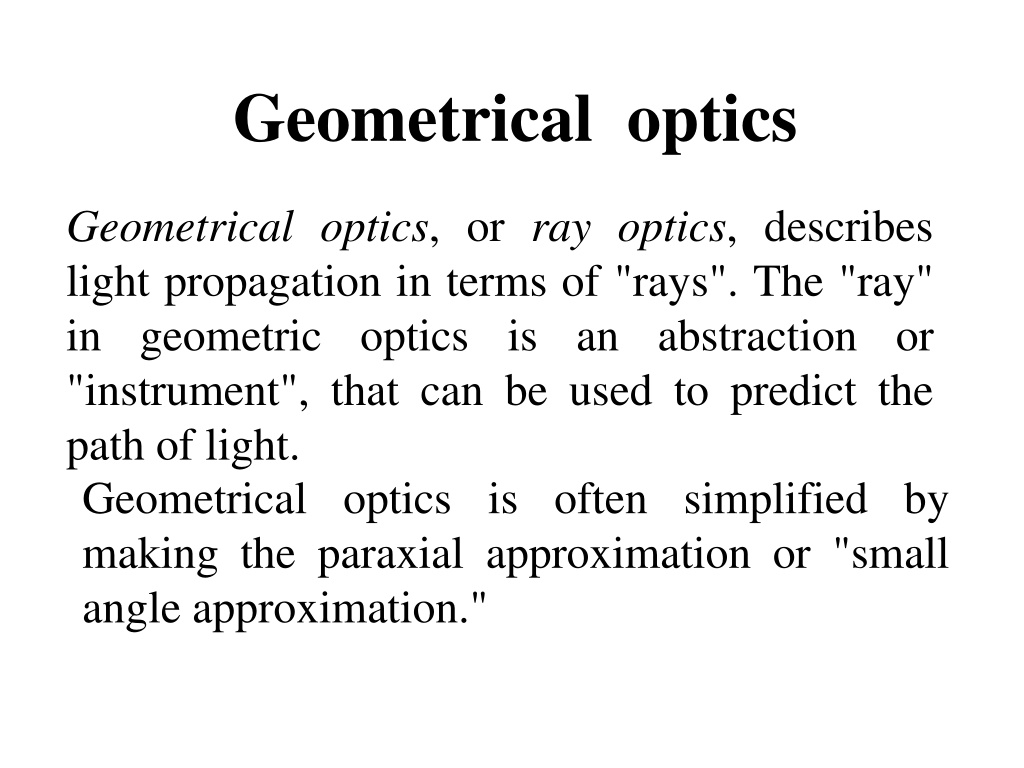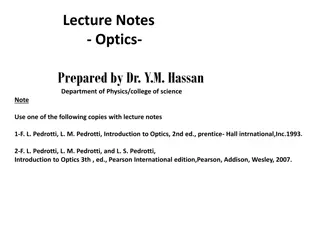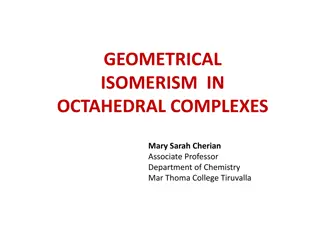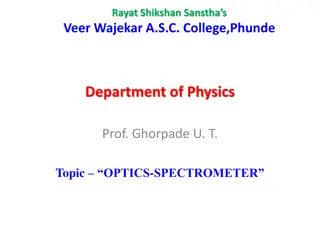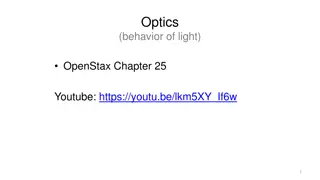Geometrical Optics
Geometrical optics, also known as ray optics, explores the behavior of light using rays as an abstraction tool to predict light paths. This field simplifies light propagation using the paraxial approximation, focusing on reflection, refraction, total internal reflection, and its application in fiber optics and imaging techniques.
Download Presentation

Please find below an Image/Link to download the presentation.
The content on the website is provided AS IS for your information and personal use only. It may not be sold, licensed, or shared on other websites without obtaining consent from the author.If you encounter any issues during the download, it is possible that the publisher has removed the file from their server.
You are allowed to download the files provided on this website for personal or commercial use, subject to the condition that they are used lawfully. All files are the property of their respective owners.
The content on the website is provided AS IS for your information and personal use only. It may not be sold, licensed, or shared on other websites without obtaining consent from the author.
E N D
Presentation Transcript
Geometrical optics Geometrical optics, or ray optics, describes light propagation in terms of "rays". The "ray" in geometric optics is an abstraction or "instrument", that can be used to predict the path of light. Geometrical optics is often simplified by making the paraxial approximation or "small angle approximation."
Reflection and refraction of light. Refractive index Light incident upon a surface will in general be partially reflected and partially transmitted as a refracted ray. The reflection law: the angle of incidence is equal to the angle of reflection. The index of refraction of medium is defined as the speed of light in vacuum divided by the speed of light in the medium. n = = c v Snell's Law: sin n = = 2 n 21 sin n 1
Total Internal Reflection When light is incident upon a medium of lesser index of refraction, the ray is bent away from the normal, so the exit angle is greater than the incident angle. Such reflection is commonly called "internal reflection". The exit angle will then approach 90 for some critical incident angle c, and for incident angles greater than the critical angle there will be total internal reflection. The critical angle can be calculated from Snell's law by setting the refraction angle equal to 90 . Total internal reflection is important in fiber optics.
Fiber Optics The field of fiber optics depends upon the total internal reflection of light rays traveling through tiny optical fibers. The fibers are so small that once the light is introduced into the fiber with an angle within the confines of the numerical aperture of the fiber, it will continue to reflect almost losslessly off the walls of the fiber and thus can travel long distances in the fiber. Bundles of such fibers can accomplish imaging of otherwise inaccessible areas.
Fiber optic maging uses the fact that the light striking the end of an individual fiber will be transmitted to the other end of that fiber. Each fiber acts as a light pipe, transmitting the light from that part of the image along the fiber. If the arrangement of the fibers in the bundle is kept constant then the transmitted light forms a mosaic image of the light which struck the end of the bundle.
Prisms A refracting prism is a convenient geometry to illustrate dispersion and the use of the angle of minimum deviation provides a good way to measure the index of refraction of a material. Reflecting prisms are used for orientation of an image and make use of total internal reflection instead of refraction. White light may be separated into its spectral colors by dispersion in a prism. changing the
The angle of minimum deviation for a prism may be calculated from the prism equation. Note from the illustration that this minimum deviation occurs when the path of the light inside the prism is parallel to the base of the prism. If the incident light beam is rotated in either direction, the deviation of the light from its incident path caused by refraction in the prism will be greater. Prism apex angle
Refractometry Refractometry is the method of measuring substances' refractive index (one of fundamental physical properties) in order to, for example, assess their composition or purity. A refractometer is the instrument used to measure refractive index. Although refractometers are best known for measuring liquids, they are also used to measure gases and so lids; such as glass and gemstones. A refractometer can be used to determine the identity of an unknown substance based on its refractive index, to assess the purity of a particular substance, or to determine the concentration of one substance dissolved in another. Most commonly, refractometers are used for measuring fluid concentrations such as the sugar content (Brix level, for example in carbonated beverages, fruits, juices, honey and or vegetables, etc), blood protein concentration, salinity and specific gravity of urine. Refractometers are also used for measuring fluid concentrations for commercial liquids such as antifreeze, cutting fluid, and industrial fluids.
Principal Focal Length For a thin double convex lens, all parallel rays will be focused to a point referred to as the principal focal point. The distance from the lens to that point is the principal focal length f of the lens. For a double concave lens where the rays are diverged, the principal focal length is the distance at which the back- projected rays would come together and it is given a negative sign. The lens strength in diopters is defined as the inverse of the focal length in meters.
Thin Lens Equation For a thin lens, the power is approximately the sum of the surface powers.
